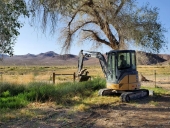posted 1 year ago
I could use input from anyone knowledgeable in this area.
I have a 1/4 acre pond about 10’-12’ deep at its center that is extremely muddy. It has been since we bought the property over 20 years ago. I have always wanted to clear the water but always ran into other things to do.
The pond is constructed on a clay base. There are (or at least were) blackhead catfish in the pond—as in hundreds of them, but they are at most 6 inches long. If I drop breadcrumbs or old cereal in the water, the fish swarm in hordes to get the free food. There are also plenty of turtles and crayfish. Plenty of aquatic birds stop in from time to time.
About 200 feet away there is another, larger pond (not on my property) whose water is crystal clear. It also has an abundance of wildlife. I don’t know if it matters, but the adjacent pond has huge pine trees that drop needles into the water.
In the past I have been recommended to use gypsum, which I did use. At one point I used a fair amount of gypsum (and by fair amount I mean 4 40 pound bags). Indeed, the water turned from chocolate milk brown to a mildly translucent blue—a definite improvement, but by no means was the water clear. The treatment only lasted a few weeks before turning brown again.
I would like to get my pond looking more like my neighbor’s pond. Is there any Permies way to do this? I have read/watched videos stating that I need to add a flocculant to the water. Apparently gypsum is one such flocculant, but it doesn’t last terribly long. There is no shortage of liquid products advertised as flocculants which probably work better than the gypsum but I just can’t tell if they are OMRI certified or Gick or something in between. I have no intention of adding gick to my pond.
And just to get it out of the way, I did talk with one expert who told me the problem was the crayfish and catfish that constantly stirred up the bottom. His proposed solution was to add gick to kill all the fish and then restock with a different species. This is not happening. I am not adding gick and restocking is expensive so that’s a double-no for me.
But if anyone has any suggestions or ideas that might be more Permie friendly, please let me know.
Eric
Some places need to be wild


 3
3





 5
5














 3
3




 6
6




 4
4




 3
3




 4
4














 3
3









